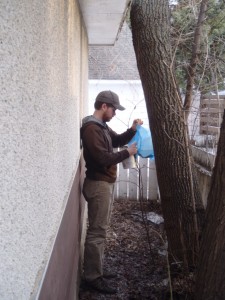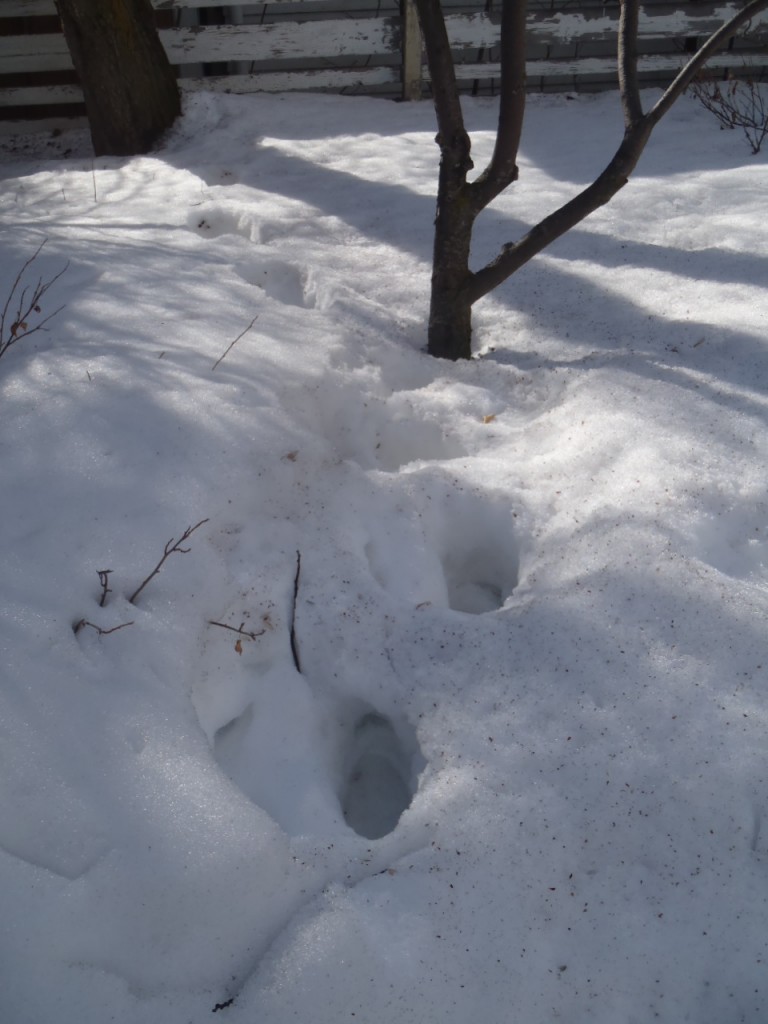
Last week I tapped my maple trees, and since then I have collected about one teaspoon of sap from the buckets.
I recently learned that the spring sap run is a completely separate phenomenon from the normal transportation of water and nutrients through the stems of the maple during the growing season. That transportation is going to happen no matter what. The sap run, on the other hand, might not, as it requires a very specific set of circumstances, and is not a biologically necessary phenomenon from the tree’s standpoint.
Before we tackle the question of why sap runs, we need some background info on maples.
Why Maple Sap Contains Sucrose in the First Place
During the summer the leaves of the maple convert carbon dioxide and water into sucrose and oxygen in a process called photosynthesis. Sucrose is very familiar to us. You might have put sucrose in your coffee this morning. The tree needs to save some of this sugar so that it can put out leaves the following year. To this end in the fall the tree converts the sucrose to starch, which it stores in its roots and trunk. In the spring the tree breaks the starch back down into sucrose.
Other types of trees do the same thing, but maples generally, and sugar maples specifically, have much higher concentrations of sucrose than most.
Sapwood and its Structure
There are two types of wood behind the bark of a maple. The older wood, at the centre of the trunk, is called heartwood, and is more or less dead. Closer to the bark we have the younger, living wood, called sapwood.
The main roll of sapwood is to convey nutrients and water between the roots below and the shoots above. There are two types of transport tissue that do this: phloem transports nutrients, while xylem deals chiefly in water. In the spring time, however, the water in the xylem also contains the abovementioned sucrose. In scientific literature xylem tissue is often referred to as a conduit, or vessel, because of its role in transportation.
The second function of the sapwood is to provide structural support to the transport tissue as well as the branches high above. One of these structural elements is wood fiber. Fiber is made of single, elongated cells which, in maples, are filled with air. The interior of a wood fiber cell is called the lumen (pl. lumina). Gas-filled fibers are unique to maples and a few other plants such as walnut and butternut trees; in most other plants the fibers are filled with liquid.
So, Why Does Maple Sap Run?
The simple answer is positive stem pressure. Sap runs when there is a buildup of pressure in the sapwood of the maple, a pressure so great that when we bore a hole into the sapwood, or if the sapwood is somehow damaged, sap is exuded from the wound. (The technical term for sap flow is “sap exudation.”)
The real question here is why positive pressure develops in the sapwood. We know from experience that freezing and thawing cycles build positive pressure in maples, but the truth is we don’t know exactly why this happens. We have a general idea, of course, but physiological botanists are still proposing models. I’d like to take some time to explain the most popular models of the last few decades.
The Physical Model of Sap Exudation (aka the Milburn-O’Malley Model)
The larger part of this model has been around for more than a hundred years, but it reached its current form in a 1984 study by Milburn and O’Malley.
When the temperature drops in the evening, the first parts of the tree to cool down are the smaller twigs and branches high in the tree. As the temperature approaches freezing, the gas in the wood fibers contracts, while the sap in the conduits expands. This creates a pressure differential across the fibers and the conduits. Sap is thereby drawn into the lumen, where it freezes to the cell wall. As it freezes it expands and further compresses the gas within the lumen.
As sap moves into the wood fibers, more sap is drawn from the lower parts of the tree into the upper branches, and the roots take in water from the ground.
When the temperature outside rises above freezing the following morning, the sap in the wood fibers melts, and is forced back into the conduits and down the tree by the pressurized gas and the force of gravity. If we have tapped the sapwood, we have relieved some of this pressure. The sap takes the path of least resistance, and much of it ends up in our bucket.
Problems with the Physical Model of Sap Exudation
While the physical model adequately explains the upward movement of sap and the intake of water by the roots during a cooling phase, it is not able to explain the hours of sustained positive pressure measured in maple stems. For a number of reasons beyond my comprehension, botanists now know that pressurized air-bubbles in the lumina can not and do not account for the high pressure measured in maple stems.
Interestingly, it has been found that if maple sap is replaced with pure water and then run through maple branches exposed to freeze-thaw cycles, there is no buildup in stem pressure (Johnson et al. 1987). The sucrose found in the sap is therefore playing some role in the process. In fact, it has been found that stem pressure and volume of exudation are positively correlated to the sucrose concentration of the sap (ibid).
This last fact got some botanists thinking about osmosis, and osmotic pressure.
Osmosis
Osmosis is the diffusion of water through a semi-permeable membrane across which there is some kind of concentration gradient. Imagine a cell. The cell wall is our semi-permeable membrane. On one side of the membrane is the interior of the cell, on the other the exterior environment. If we surround this cell with brine, there is a very high concentration of sodium ions outside the membrane, and a relatively low concentration within. Water will start to pass through the membrane from the cell to the environment, in an attempt to equalize the two concentrations of sodium. This is osmosis.
The Osmotic Model of Sap Exudation (what I, but not the scientific community, call The Tyree Model)
The osmotic model of sap exudation assumes the existence of a membrane between the conduits and the surrounding fiber cells that is permeable to water, but impermeable to sucrose. In other words, the sucrose is confined to the conduits, but water is able to move freely between the conduits and the surrounding fiber cells.
The ability of a high concentration solution to draw water through a semi-permeable membrane can be thought of as a kind of pressure, called osmotic pressure.
Take our example of the cell surrounded by brine. Water flows through the cell membrane from the interior of the cell to the exterior. Whenever water flows, it is moving from a point of high potential energy to a point of low potential energy. In a river or waterfall the water starts with a relatively high gravitational potential energy and finishes with a lower gravitational potential energy. At the start of a pipeline the water has a high potential energy because it is under pressure. The end of the pipeline is under less pressure and has a lower potential energy, making the water flow from the start to the end.
Since water flows from the interior of the cell to the briny exterior, the high concentration of sodium ions is somehow lowering the potential energy of the surroundings. This difference in potential energy across a semi-permeable membrane is called osmotic pressure.
As we discussed in the explanation of the physical model, as the branches cool, the gas in the wood fibers contracts, and sap in the conduits expands. There is therefore a pressure differential, and because of the semi-permeable membrane, water (not sap) is drawn into the fibers, while the sucrose remains in the conduits.
We now have relatively pure water in the fibers, and a relatively concentrated solution of sucrose in the conduits. This concentration gradient creates a high osmotic pressure. Once the branches warm up, the physical pressures that separated the water from the sucrose are reversed, and the water in the fibers flows back into the conduits, down the tree, and out our tap.
This is the latest and most complete theory of sap exudation. Some studies have been done that support the existance of a membrane that is permeable to water but impermeable to larger molecules like sucrose (Tyree 2008), but more work is needed to hash out the details of the osmotic model.
A Bunch of Caveats
The information I’ve presented here is hugely simplified. There are entire issues that I have completely avoided (like air bubble formation and stability in the lumina), not because I don’t want to write about them, but because I don’t understand them at all. I’m not a physiological botanist, and have probably misrepresented facts even in this abbreviated explanation.
Anyways. Even if I’ve botched some of the details, the point is that sap flow is a completely separate mechanism from the usual transportation of sugar and water through the tree, and not one that is required for the plant to grow. If the outside temperature does not cycle about 0°C, water will not be drawn into the surrounding fibers, and pressure will not build in the sapwood. This has been an exceptionally early, warm spring, and I don’t think we’ll get the freeze-thaw cycles that we need for a good sap run. But we’ll see.
References
Johnson, R.W., M.T. Tyree and M.A. Dixon. 1987. A requirement for sucrose in xylem sap flow from dormant maple trees. Plant Physiol. 84:495–500
Milburn, J.A. and P.E.R O’Malley. 1984. Freeze-induced sap absorption in Acer pseudoplatanus: a possible mechanism. 62:2101–2106.
Tyree, M.T., Cirelli D., Jagels R. 2008. Toward an improved model of maple sap exudation: the location and role of osmotic barriers in sugar maple, butternut and white birch. Tree Physiol. 28(8):1145-55
